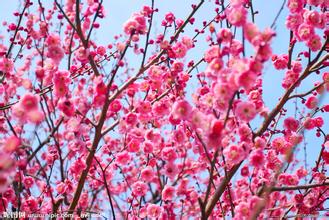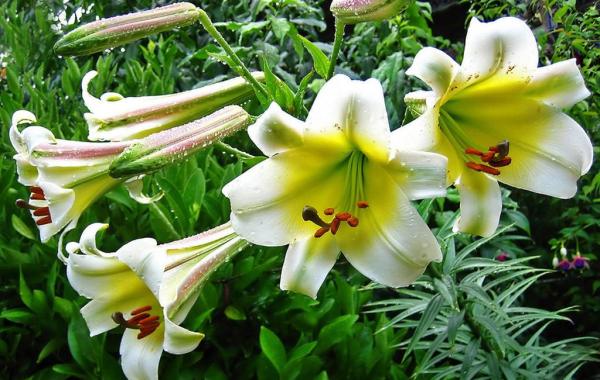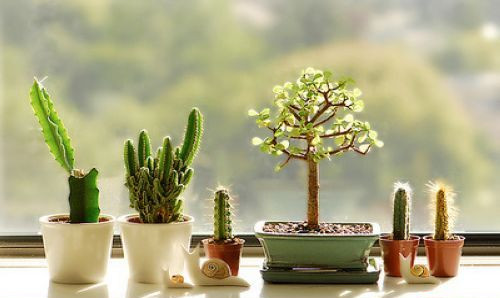How to cultivate plum blossom in family
Plum blossom, alias dried plum, spring plum, red plum, green plum and so on. Sexual preference for adequate light, warm, humid, well-ventilated environment, cold tolerance can be strong, but can not withstand the low temperature below-15 degrees Celsius, not resistant to waterlogging. Avoid stagnant water, resistant to barren. Grow well in fertile, loose, humus-rich neutral or slightly acidic soil. It blossoms when the temperature reaches 6-7 degrees Celsius. The main method of propagation is grafting, and it can also be used for striping, cutting, sowing and propagation.
Breeding method: the surviving plum seedlings were propagated by grafting and put on the pot at the end of autumn. The pot soil was mixed with 1 part of garden soil, 1 part of coarse sand, half part of rotten cake fertilizer, or 4 parts of rotten leaf soil, 4 parts of compost soil and 2 parts of sand. The basin bottom cushion is covered with broken tiles to facilitate drainage. Plum seedlings with small earthen balls will be planted in the basin when they are put on the pot. Water thoroughly after planting, place in a sunny ventilated place, if placed in a shaded place, it will grow badly. Watering should be controlled during the growth period. Too much humidity will affect root growth and lead to poor development of fallen leaves and flower buds. Watering should see that the basin soil is dry and wet, and if it is not dry, it will be watered thoroughly, but stagnant water should be prevented. If it is found that iron deficiency causes yellowing of leaves during the growth period, it can be combined with watering and apply 0.1% ferrous sulfate solution.

Watering in summer is the key, watering once in the morning and evening, and spraying water to the plant and the ground to improve the air humidity. By the end of June, when the new branch grows to 20-25 cm, it should be properly "watered" (that is, not watered). When the tender shoots wilt, water them again. The amount of water is gradually reduced in autumn, and it is watered once every 2 to 3 days to survive the winter. Strictly control watering in winter; fertilize during the growth period. From April to May, apply rotten and thin cake fertilizer every month to promote luxuriant branches and leaves; from late June to early July, topdressing calcium superphosphate and potassium chloride to promote flower bud formation; in early August, topdressing phosphate fertilizer to promote flower bud hypertrophy, early September. Need to spray 0.1% 0.2% potassium hydrogen phosphate 2 times to promote flower color.
At the beginning of the month, when plum blossoms are budding, one quick-acting fertilizer is applied to promote the blooming of plum blossoms. After each fertilization, we should pay attention to timely watering and loosening the soil, so as to loosen the basin soil to facilitate root development; pruning is usually carried out after flowering, and trees with strong or young trees should be cut lightly; weak trees or old plum stumps should be heavily cut. Strong branches should be cut lightly, weak branches should be cut heavily, while disease and insect branches, overgrown branches, weak branches and withered branches should be cut off at any time. Properly cut the main and lateral branches that have flowered, and then leave 2-3 buds in the main school, 5-6 buds in the long branches, and 3-5 main branches in the plant, so that the length, height and density are suitable. How to cultivate plum blossom
Plum blossom has been cultivated in China for more than 3000 years. It is a plant with great ornamental and cultural symbol. How to raise plum blossom? Today, I'm going to tell you about the cultivation of plum blossoms.
1. It can be planted in the south and cold-tolerant varieties in the Yellow River basin, but it should be pot-planted indoors in the cold areas of the north. It can be planted after falling leaves to before budding in spring plum blossom season. In order to improve the survival rate, root damage should be avoided and transplanting with soil masses should be avoided. The land should be planted in a place that is leeward and sunny. The pot culture soil was evenly mixed with 3 parts of rotten leaf soil, 3 parts of garden soil, 2 parts of river sand and 2 parts of rotten barnyard manure. Water once after planting. Keep it in the shade and move it to normal management in the sun after resuming growth.
2. Light and temperature prefer warm and sufficient light. Except that the varieties of apricot plum can withstand the low temperature of-25 ℃, they are generally tolerant to low temperature of-10 ℃. It is resistant to high temperature and can grow at 40 ℃. The growth and development is the best in the area with annual average temperature of 16-23 ℃. It is very sensitive to temperature and blossoms when the average temperature reaches-5: 7 ℃ in early spring.
3. During the growing period of watering and fertilization, we should pay attention to watering, often keep the basin soil moist, neither stagnant water, nor too wet or too dry. Generally overcast, when the temperature is low, less watering, otherwise more watering. It can be watered twice a day in summer, once a day in spring and autumn, and thoroughly dry in winter. Fertilization is also reasonable, apply basic fertilizer before planting, add a small amount of potassium dihydrogen phosphate at the same time, apply potassium dihydrogen phosphate again before flowering, and apply mature cake fertilizer for one time to supplement nutrition. Compound fertilizer can also be applied once in June to promote flower bud differentiation. After falling leaves in autumn, apply organic fertilizer once, such as rotten manure and so on.
4. The shaping and pruning time of plum blossom can be carried out within 20 days after blossom. Mainly in the shape of a natural tree, cut off cross branches, erect branches, dry and withered branches, over-dense branches, etc., and cut short lateral branches to promote flowers and leaves to flourish. After the potted plum blossom is put on the pot, it should be re-cut to lay the foundation for the production of bonsai. Plum stakes are usually used as scenes to graft plum blossoms in various postures. Keeping a certain temperature, plum blossoms can be seen in full bloom during the Spring Festival. If you want to blossom on May Day, you need to keep the temperature 0: 5 ℃ and moist environment. Move outside in early April and keep it in a sunny and well-ventilated place to see flowers before and after May Day.
5. Flowering period control potted plum blossom is generally for family viewing. Leave the leaves indoors after defoliation in winter, keep the temperature at 0: 5 ℃, then gradually heat to 5: 10 ℃, and receive full light every day, often spray water on the branches, the moisture should be close to the room temperature.
Is the plum blossom poisonous? is the plum blossom suitable for raising at home / toxic / there are advantages and disadvantages of raising plum blossoms at home
Prickly plum blossom is a highly ornamental flower with a bright color, so many people want to raise this plant at home. However, it is important to note that if you want to raise a plant at home, you first need to know if it is poisonous. On the question of whether the thorn plum blossom is poisonous and whether it is suitable for raising at home, let's take you to know it.
Is the thorn plum blossom poisonous?
On the question of whether the plum blossom is poisonous, in fact, the answer is that it is toxic to a certain extent. The plum blossom is a kind of plant with strong self-protection ability. When it is infested by pests, it secretes some toxic white juice from the wound. This juice can stick to the pests so that they can not move.
Although it is secreted by self-protection, it still has a certain impact on the human body, especially on the skin. If you inadvertently eat this juice, it will cause dizziness and vomiting. So you have to pay attention to this.
Is it poisonous to put the plum blossom in the bedroom?
Although the plum blossom plant will secrete toxic substances when it opens the mode of self-protection, this phenomenon will not occur as long as it is properly maintained, and many of the ornamental flowers are toxic to a certain extent. but it is not harmful to people, so we can analyze this problem from a rational point of view.
Third, is the plum blossom suitable for raising at home / there are advantages and disadvantages
On the question of whether the plum blossom is suitable for raising at home, it can be said that it has both advantages and disadvantages. Although it has a certain degree of toxicity, it also has many benefits for people. It depends on how you think about this.
1. Malpractice
In the above, the editor also mentioned that this plant is toxic to a certain extent, which is also the only drawback of home farming. Although it does not occur often, it still has a certain probability of happening, so it depends on how you choose.
two。 Benefit
After talking about the disadvantages, home culture of plum blossoms also has a lot of benefits, the most important thing is its ornamental, of course, it also has many functions, in the article on the efficacy and function of plum blossoms, there is a detailed introduction to this aspect. Interested friends can learn about it.
- Prev

Management method of potted flower rainy season
Prevent stagnant water. Pots placed in the open world are easy to accumulate water after rain. if they are not eliminated in time, the water in the pot soil will form a saturated state, resulting in insufficient air and serious hypoxia, which is extremely disadvantageous to the root growth of flowers. Especially some varieties that are more afraid of waterlogging.
- Next

The time of watering flowers in winter
Many flowers need less watering in winter, and many flower friends can not grasp the time of watering flowers in winter. This article briefly introduces the time of watering flowers in winter, which is convenient for flower friends to refer to. First of all, florists should know that they should not water flowers too much in winter, because water evaporation is small in winter.
Related
- Fuxing push coffee new agricultural production and marketing class: lack of small-scale processing plants
- Jujube rice field leisure farm deep ploughing Yilan for five years to create a space for organic food and play
- Nongyu Farm-A trial of organic papaya for brave women with advanced technology
- Four points for attention in the prevention and control of diseases and insect pests of edible fungi
- How to add nutrient solution to Edible Fungi
- Is there any good way to control edible fungus mites?
- Open Inoculation Technology of Edible Fungi
- Is there any clever way to use fertilizer for edible fungus in winter?
- What agents are used to kill the pathogens of edible fungi in the mushroom shed?
- Rapid drying of Edible Fungi

